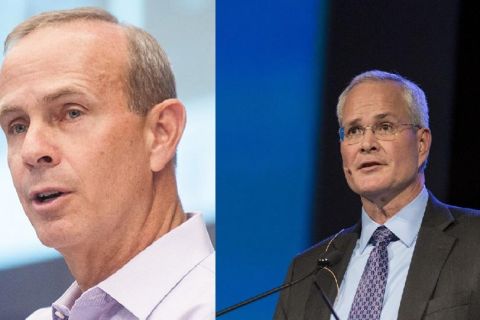Presented by:

[Editor's note: A version of this story appears in the March 2021 issue of Oil and Gas Investor magazine. Subscribe to the magazine here.]
Soak up the A&D love, Bakken Shale. The reports are true. As of early February, two sellers and two buyers did what comes naturally: transact.
One deal could perhaps be read as a misfire—a confused visitor arriving at the wrong address. But two? In the Bakken, that’s a trend.
On Feb. 10, Equinor ASA (née Statoil) agreed to part with the entirety of its Bakken position for about $900 million—a stunning sum considering the $9.2 billion in onshore shale and other assets Equinor has already written off. Equinor entered the Bakken in 2011 with the acquisition of Brigham Exploration Co. for $4.7 billion.
Taking custody of the company’s 242,000 net acres and roughly 48,000 boe/d production will be Grayson Mill Energy LLC, an EnCap Investments LP-backed company headed by CEO Eric Bayes. Bayes previously headed completions and production for Occidental Petroleum.
Equinor’s plainspoken rationale was along the lines of, “It’s not you. It’s oil.”
“We are taking action to improve the profitability of Equinor’s international oil and gas business. [The] announcement on the exit of our Bakken assets is an important step in this process,” Al Cook, Equinor’s executive vice president of development and production, said in a press release.
The deal comes after the rusted A&D machinery in magical North Dakota screeched to life in January.
Enerplus Corp. agreed on Jan. 25 to acquire Bruin E&P Partners LLC for $465 million cash in a deal it described as “highly complementary” to its existing acreage. Bruin holds a 150,000 net acre position in the Bakken, including 30,000 net acres around Fort Berthold, with 135 net drilling locations.
After the deal closes, the company’s projected liquids production is projected to average about 65,000 bbl/d at the midpoint. The company also sees its debt falling to 1.3x.
Based in Houston, Bruin E&P Partners holds 151,000 net acres in the Williston Basin all located within North Dakota. The acquisition includes 30,000 net acres contiguous with Enerplus’ Tier 1 acreage position in the Bakken, plus significant production and development inventory concentrated in the Fort Berthold area.
Enerplus also expects more than $200 million in free-cash-flow generation with Bruin’s assets. Of course, for any responsible person, such predictions should come with a caveat emptor (or is it cave canem?).
Enerplus estimates are based on $50/bbl WTI and $2.75/Mcf prices and assumed Bakken differentials of $3.25/bbl of oil, down from $5/bbl. For examples of where these sort of predictions can go wrong, see “industry, oil and gas.”
Still, Enerplus and Grayson Mill Energy have the benefit of paying a price more tethered to reality than their predecessors. That’s been the trend the past five years, as asset prices have gone from high to absurd to fairly reasonable valuations.
For the Bakken, it’s also good to see a pair of deals adding up to Permian money—about $1.36 billion. That’s the largest bankroll unfurled in the Williston Basin since April 2019, when Northern Oil & Gas Inc. purchased Flywheel Energy Production assets for $310 million.
Look for additional deals in these more mature, more street-wise basins to flow in 2021, said Jason Martinez, a strategic adviser and former head of BMO’s U.S. A&D business.
“I believe there are literally hundreds of millions of barrels of production waiting to trade hands,” he said. “And they’re waiting on pricing and they’re waiting on financing.”
Sellers will include conventional businesses that are coming out of independents, legacy assets that have been written off and underperforming assets that will come out of independents.
Presciently, Martinez predicted that companies that emerge from bankruptcy, particularly in certain basins, will be marketing to pay off debt or pay off new equity owners.
Martinez said he expected companies with a lot of “maturity, basically PDP [proved developed producing] decline rates in the Bakken [and] Eagle Ford that will probably come to the market.”
Companies that have made consolidation moves are also potential sellers.
“Clearly there are big pieces of some of the mergers that just don’t make sense in that pro forma company,” he said.
The market just needs some time. OK, some more time. Really, after last year’s end-of-times scale crash, shale’s A&D pace is recovering about as quickly as anyone could have expected.
Recommended Reading
Matador Resources Announces Quarterly Cash Dividend
2024-04-18 - Matador Resources’ dividend is payable on June 7 to shareholders of record by May 17.
CEO: Coterra ‘Deeply Curious’ on M&A Amid E&P Consolidation Wave
2024-02-26 - Coterra Energy has yet to get in on the large-scale M&A wave sweeping across the Lower 48—but CEO Tom Jorden said Coterra is keeping an eye on acquisition opportunities.
The One Where EOG’s Stock Tanked
2024-02-23 - A rare earnings miss pushed the wildcatter’s stock down as much as 6%, while larger and smaller peers’ share prices were mostly unchanged. One analyst asked if EOG is like Narcissus.
The OGInterview: Petrie Partners a Big Deal Among Investment Banks
2024-02-01 - In this OGInterview, Hart Energy's Chris Mathews sat down with Petrie Partners—perhaps not the biggest or flashiest investment bank around, but after over two decades, the firm has been around the block more than most.
Exxon, Chevron Tapping Permian for Output Growth in ‘24
2024-02-02 - Exxon Mobil and Chevron plan to tap West Texas and New Mexico for oil and gas production growth in 2024, the U.S. majors reported in their latest earnings.






